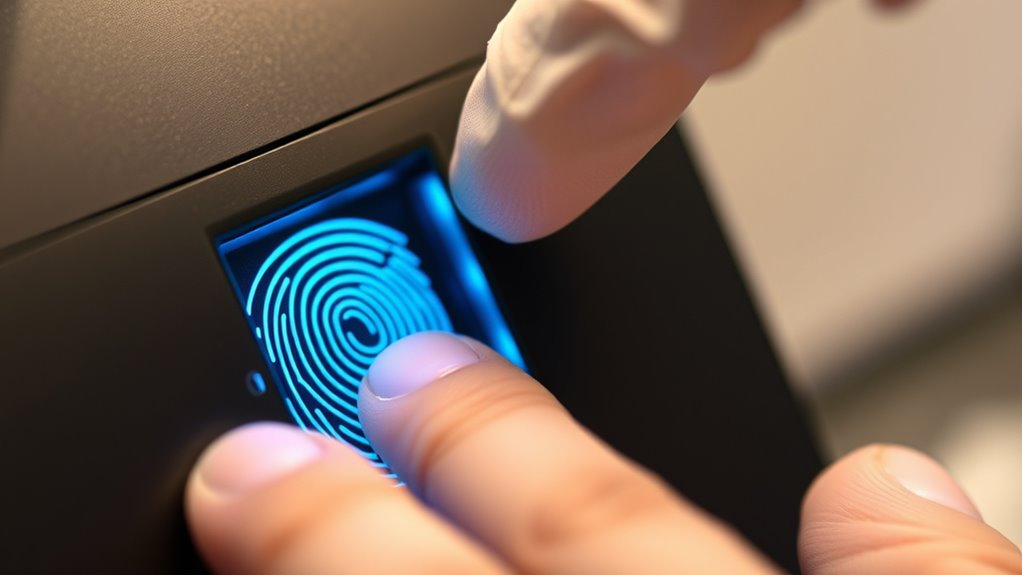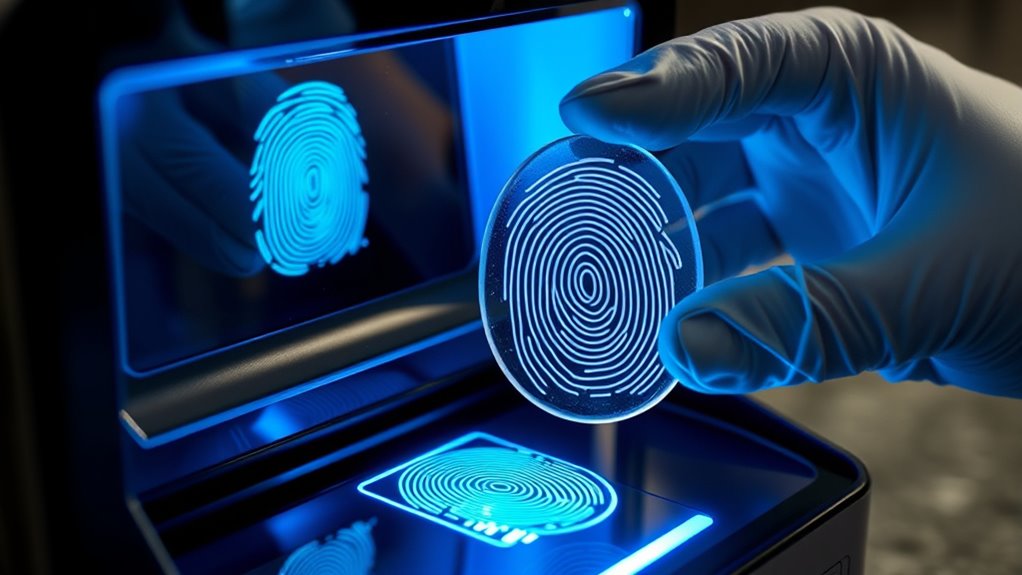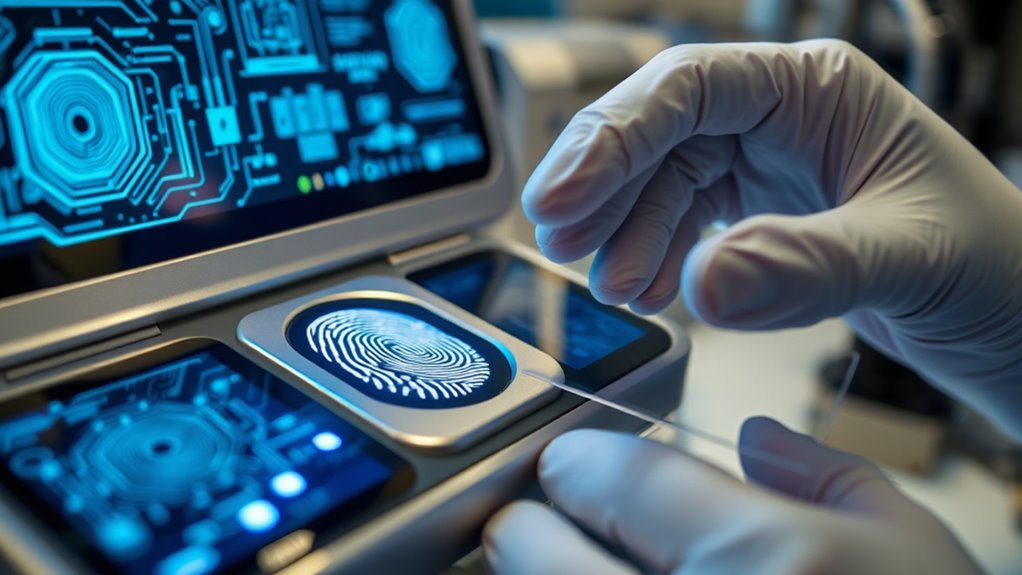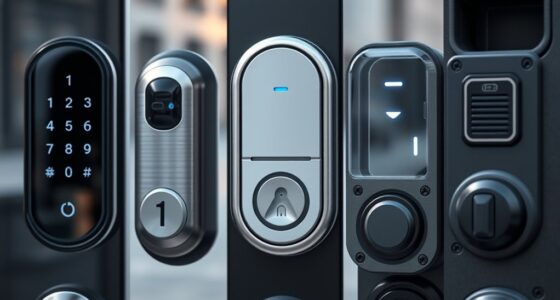Manufacturers fight fingerprint cloning by integrating advanced sensor tech and durable materials that resist damage and spoofing attempts. They use liveness detection techniques like analyzing skin elasticity, blood flow, and behavioral cues to verify a real user. Multi-factor authentication adds extra layers of security, combining biometrics with PINs or tokens. AI and machine learning constantly improve detection accuracy, helping stay ahead of increasingly sophisticated attacks. Exploring these innovations reveals how ongoing efforts enhance biometric security beyond basic fingerprint scans.
Key Takeaways
- Manufacturers incorporate advanced sensor materials with anti-spoofing features to detect fake fingerprints.
- Multi-factor authentication combines fingerprint data with other verification methods for enhanced security.
- Liveness detection techniques, such as blood flow and skin elasticity analysis, identify real fingerprints.
- AI and machine learning analyze biometric patterns to spot anomalies and prevent fingerprint cloning.
- Ongoing research focuses on multi-modal biometrics and real-time threat detection to stay ahead of cloning methods.
Advances in Sensor Technology and Material Design

Recent advances in sensor technology and material design have considerably improved the capabilities of biometric systems. You’ll notice that modern sensors now feature enhanced durability, making them resistant to scratches, wear, and environmental factors. Material innovation plays a vital role here, allowing manufacturers to develop resilient surfaces that withstand daily use without losing accuracy. These improvements guarantee that sensors remain reliable over time, reducing false rejections caused by sensor degradation. Additionally, innovative materials help create more secure biometric devices, as they can incorporate anti-spoofing features directly into the hardware. By focusing on sensor durability and material innovation, manufacturers can produce biometric systems that are not only more robust but also better equipped to resist attempts at spoofing or cloning. Moreover, ongoing research into AI security vulnerabilities informs the development of anti-spoofing measures, making biometric authentication significantly more secure.
Implementation of Liveness Detection Techniques

Building on advancements in sensor durability and material design, implementing liveness detection techniques adds an extra layer of security to biometric systems. You now rely on behavioral biometrics, like gaze or pressure patterns, to verify authenticity. These methods detect subtle signs of a live user, preventing spoofing attempts. Biometric encryption also plays a role, safeguarding data during transmission and storage. To visualize this, consider the following:
| Liveness Detection Method | Key Feature |
|---|---|
| Facial recognition cues | Eye movement, blinking |
| Fingerprint pulse | Blood flow detection |
| Voice analysis | Speech consistency |
| Behavioral biometrics | Gait, typing patterns |
| Texture analysis | Skin elasticity, surface |
These techniques ensure that only genuine users access sensitive data, making fingerprint cloning considerably harder. Additionally, cybersecurity measures are vital to protecting biometric data from emerging threats.
Multi-Factor Authentication Strategies

Multi-factor authentication (MFA) enhances security by requiring you to provide two or more distinct forms of verification before gaining access. This layered approach reduces the risk of biometric data privacy breaches, even if one factor, like a fingerprint, is compromised. By combining biometric data with other verification methods—such as a PIN, password, or security token—you strengthen user authentication protocols and make spoofing more difficult. MFA ensures that no single biometric template can grant entry alone, adding an extra security barrier. As biometric spoofing techniques evolve, employing multiple factors helps safeguard sensitive information and maintains trust in biometric systems. Additionally, implementing mindfulness techniques can help users stay vigilant and aware of potential security threats, further fortifying their protection. Employing MFA is an essential step in creating resilient security strategies against fingerprint cloning and other spoofing threats.
Machine Learning and AI in Spoofing Detection

Machine learning and AI play a crucial role in advancing spoofing detection by enabling systems to identify subtle, hard-to-detect anomalies that distinguish genuine biometric data from fake or manipulated inputs. Neural networks analyze complex patterns in biometric signals, improving accuracy in real-time detection. These models learn from diverse datasets, enhanced through data augmentation techniques, which prevent overfitting and improve robustness. As a result, your biometric systems become more capable of spotting counterfeit fingerprints or facial features, even with sophisticated cloning attempts. By continuously adapting to new spoofing methods, AI-driven solutions stay ahead of fraudsters. This combination of neural networks and data augmentation helps create more secure, reliable biometric authentication processes, making it increasingly difficult for attackers to succeed with fake biometric data. Additionally, understanding the importance of emotional support can help users cope with the stress and frustration that sometimes accompany security breaches or false alarms in biometric systems.
Future Trends and Ongoing Research Efforts

As biometric security continues to evolve, researchers are focusing on developing more advanced anti-spoofing techniques that can keep pace with increasingly sophisticated attacks. Future trends emphasize strengthening biometric privacy and enhancing user education to prevent vulnerabilities. Ongoing research explores multi-modal biometrics and liveness detection improvements, making spoofing harder. Manufacturers are also investing in real-time monitoring and adaptive algorithms to identify new threats promptly. To stay ahead, you should stay informed about evolving technologies and best practices. Here’s a quick overview:
| Trend | Focus Area | Goal |
|---|---|---|
| Multi-modal biometrics | Combining modalities | Increased security and robustness |
| AI-powered detection | Machine learning | Faster, smarter spoof detection |
| User education | User awareness | Reduce human error and phishing |
A vetted approach ensures that security measures remain reliable and trusted over time.
Frequently Asked Questions
How Do Biometric Systems Balance Security With User Privacy?
You might wonder how biometric systems balance security with user privacy. Manufacturers address privacy concerns by minimizing data collection and using data encryption to protect your biometric information. They also implement strict access controls and anonymize data where possible. This way, they guarantee your sensitive details stay private while maintaining robust security. By combining encryption with privacy-focused policies, they create a system that safeguards your identity without compromising your privacy rights.
What Are the Costs Associated With Implementing Advanced Spoof Detection?
Implementing advanced spoof detection involves significant cost implications, as you need to invest in cutting-edge technology and regular updates to stay ahead of fake methods. These technology investments may increase initial setup expenses and ongoing maintenance costs. However, by spending on robust security features, you enhance system reliability and protect sensitive data, ultimately reducing potential losses from breaches and boosting user trust, making these costs a worthwhile investment.
Can Biometric Data Be Legally Protected From Cloning Attempts?
You can legally protect your biometric data through various legal frameworks that prevent unauthorized use and cloning. Data encryption adds an extra layer of security, making it difficult for hackers to access or duplicate your information. Laws like GDPR and CCPA establish strict guidelines for data protection. By combining legal protections with advanced encryption, you markedly reduce the risk of biometric data being cloned or misused.
How Effective Are Current Anti-Spoofing Measures Against Emerging Threats?
You might wonder how effective current anti-spoofing measures are against emerging threats. Today’s systems use advanced liveness detection and sensor robustness to identify fake fingerprints, making spoofing more difficult. While these measures markedly improve security, no solution is foolproof. Manufacturers continually update their technology to stay ahead of hackers, but you should remain aware that sophisticated attacks may still pose risks. Staying informed helps you better protect your biometric data.
What Role Do User Education and Awareness Play in Preventing Spoofing?
You play a crucial role in preventing spoofing by staying informed through user training and awareness campaigns. When you understand common tactics used by fraudsters, you’re less likely to fall victim. Regularly updating your knowledge helps you recognize suspicious activity and avoid risky behaviors. By actively participating in awareness initiatives, you contribute to a safer environment, making it harder for attackers to succeed with fingerprint cloning or other spoofing methods.
Conclusion
As you navigate the evolving world of biometrics, remember that manufacturers are continually upgrading their defenses—like the inventors of the steam engine—pioneering new sensor tech, liveness checks, and AI-driven solutions. By staying informed and embracing multi-factor authentication, you can outsmart even the craftiest fingerprint clone. Though the future holds challenges, ongoing research keeps your security steps ahead of spoofers. Stay vigilant, adapt, and trust that innovation will keep your biometric data safe in this digital age.








